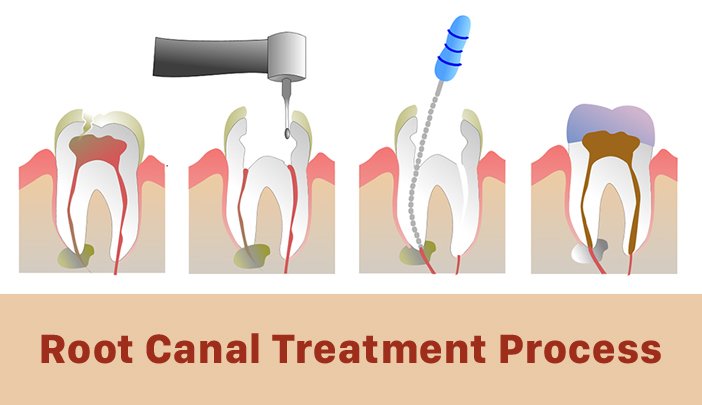Root canal treatment can be a daunting prospect for many patients, but understanding the process can help alleviate any fears and anxieties. In this blog post, we will delve into the ins and outs of root canal treatment, from the causes that lead to the need for the procedure, to the steps involved in the process itself. We will also discuss what you can expect after the procedure and tips on how to care for your mouth to ensure a successful outcome. By the end of this post, you will have a better understanding of root canal treatment and the role it plays in maintaining the health of your teeth and gums.
Introduction:
Root canal treatment is a common dental procedure that is performed to save a damaged or infected tooth. The procedure involves removing the infected or damaged pulp, cleaning and shaping the canals, and filling and sealing the canals to prevent further infection. Root canal treatment is often the best option for preserving a damaged or infected tooth, rather than extracting it.
Despite its prevalence, many people have misconceptions and fears surrounding root canal treatment. Some believe that the procedure is painful or that it may cause more harm than good. Others may be hesitant to undergo the procedure due to the cost. It’s important to understand that root canal treatment is a routine procedure that is performed by a dentist or endodontist, and is designed to alleviate pain and preserve your natural teeth.
In this blog post, we will delve into the ins and outs of root canal treatment, from the causes that lead to the need for the procedure, to the steps involved in the process itself. We will also discuss what you can expect after the procedure and tips on how to care for your mouth to ensure a successful outcome. By the end of this post, you will have a better understanding of root canal treatment and the role it plays in maintaining the health of your teeth and gums.
A. Explanation of root canal treatment and its purpose
Root canal treatment, also known as endodontic therapy, is a procedure that is performed to save a damaged or infected tooth. The procedure involves removing the infected or damaged pulp, which is the soft tissue inside the tooth that contains nerves and blood vessels. Once the pulp is removed, the dentist or endodontist will clean and shape the canals, which are the small spaces inside the tooth, and fill and seal them to prevent further infection.
The purpose of root canal treatment is to preserve the natural tooth, rather than extracting it. This is important as losing a natural tooth can cause problems with biting and chewing, and may also lead to the shifting of remaining teeth which can cause bite issues and jaw pains. Also, a missing tooth can cause the surrounding teeth to shift, which can lead to problems with your bite and difficulty with cleaning. By preserving the natural tooth, root canal treatment helps to maintain the health and function of the tooth, as well as the overall health of your mouth.
B. Common misconceptions and fears surrounding the procedure
Despite its prevalence, many people have misconceptions and fears surrounding root canal treatment. Some believe that the procedure is painful, but the reality is that most people experience little to no pain during the procedure and any discomfort that you may feel can be controlled with local anesthesia. Also, many patients who undergo root canal treatment report that their tooth feels better after the procedure as the source of pain, which is the infected or inflamed pulp, is removed.
Another common misconception is that root canal treatment may cause more harm than good. In fact, root canal treatment is often the best option for preserving a damaged or infected tooth, and can help prevent the need for more extensive and costly procedures in the future.
The cost of root canal treatment can be another concern for some people. However, it is important to keep in mind that preserving your natural tooth with root canal treatment can save you money in the long run, compared to the cost of a tooth extraction and artificial tooth replacement.
Overall, root canal treatment is a routine procedure that is performed by a dentist or endodontist and is designed to alleviate pain and preserve your natural teeth. With the advancement of technology, the procedure has become less invasive, more efficient and less time-consuming. In this blog post, we will delve into the ins and outs of root canal treatment and provide you with the information you need to understand the procedure and alleviate any fears or misconceptions you may have about it.
Reasons for Needing a Root Canal
Decay and infection:
One of the most common causes of the need for a root canal is decay and infection. When tooth decay is left untreated, it can lead to the formation of cavities, which can then spread to the pulp of the tooth. The soft layer that houses blood vessels and nerves inside the tooth is called the pulp. When the pulp becomes infected, it can cause severe pain, swelling, and sensitivity to hot and cold temperatures. In this case, a root canal is necessary to remove the infected pulp and save the tooth.
Trauma to the tooth:
Another common cause of the need for a root canal is trauma to the tooth. Trauma can occur from a variety of causes, such as a sports injury, a fall, or a car accident. When a tooth is knocked out or severely damaged, it can cause injury to the pulp, which can lead to infection or inflammation. In these cases, a root canal is often necessary to remove the damaged pulp and save the tooth.
Complications from previous dental work:
Sometimes, the need for a root canal can be caused by complications from previous dental work. For example, if a filling or crown is not placed correctly, it can lead to decay or infection of the pulp. In addition, if a previous root canal was not performed properly, or if the restoration failed, it may also lead to the need for a repeat procedure.
In all these cases, root canal treatment is necessary to remove the infected or damaged pulp, clean and shape the canals, and fill and seal them to prevent further infection. This will help to preserve the natural tooth and maintain the health and function of the tooth, as well as the overall health of your mouth. In the next section, we will discuss the steps involved in the root canal treatment process and what you can expect during the procedure.
Steps Involved in the Root Canal Treatment Process
Diagnosis and preparation:
The first step in the root canal treatment process is to diagnose the problem and prepare for the procedure. The dentist or endodontist will take x-rays and perform a thorough examination of the tooth to determine the extent of the damage or infection. They will also discuss any relevant medical history and any allergies you may have. They can use this information to decide on the best course of treatment for you.
Anesthesia and numbing the area:
Before the procedure begins, the dentist or endodontist will administer local anesthesia to numb the area around the tooth. This will help to minimize any discomfort or pain during the procedure.
Removing infected or damaged pulp:
Once the area is numb, the dentist or endodontist will make an opening in the top of the tooth to access the pulp chamber and root canals. Using special instruments, they will remove the infected or damaged pulp, being careful to preserve as much healthy tooth structure as possible.
Cleaning and shaping of the canals:
After the pulp has been removed, the dentist or endodontist will clean and shape the canals to remove any remaining debris. They will also use an antimicrobial solution to kill any remaining bacteria and prevent further infection.
Filling and sealing the canals:
Once the canals have been cleaned and shaped, the dentist or endodontist will fill and seal them. They will use a special material called gutta-percha, which is a rubber-like substance that is inserted into the canals and then sealed. This helps to prevent bacteria from entering the canals and re-infecting the tooth.
Placement of a crown or filling:
Finally, the dentist or endodontist will place a temporary filling in the opening of the tooth. A permanent filling or crown will be placed at a later appointment, after the tooth has had time to heal. This will help to protect and strengthen the tooth, and restore its function.
The entire process of root canal treatment may take one or more appointments to complete, depending on the complexity of the case. But with the advancements in technology, the procedure has become more efficient and less time-consuming. The dentist or endodontist will provide you with detailed instructions on how to care for your tooth after the procedure to ensure a successful outcome.
Aftercare and Recovery
Expectations for pain and discomfort:
After root canal treatment, you may experience some mild pain and discomfort. This is normal and can be managed with over-the-counter pain medication and anti-inflammatory drugs as prescribed by your dentist or endodontist. You may also experience some sensitivity to hot and cold temperatures for a short period of time. Your dentist or endodontist will provide you with detailed instructions on how to manage any pain or discomfort.
How to care for your mouth post-procedure:
To ensure a successful outcome, it’s important to properly care for your mouth after the procedure. You should avoid biting or chewing on the treated tooth for a few days after the procedure, and be gentle when brushing the area. You should also avoid hard or crunchy foods, and stick to a soft diet until the tooth fully heals. Your dentist or endodontist will provide you with detailed instructions on how to care for your mouth after the procedure.
Follow-up appointments and monitoring:
After the root canal treatment, the dentist or endodontist will schedule a follow-up appointment to check on the healing of the tooth and to place a permanent filling or crown. It’s important to attend this appointment and any other follow-up appointments as scheduled. During the follow-up appointment, the dentist or endodontist will take x-rays to ensure the tooth has fully healed, and that the root canal treatment was successful. They will also monitor the tooth for any signs of infection or complications.
Overall, root canal treatment is a routine procedure that is performed by a dentist or endodontist and is designed to alleviate pain and preserve your natural teeth. With proper care and monitoring, the treated tooth can last a lifetime.
Conclusion:
Root canal treatment is a common dental procedure that is performed to save a damaged or infected tooth. The procedure involves removing the infected or damaged pulp, cleaning and shaping the canals, and filling and sealing the canals to prevent further infection. Root canal treatment is often the best option for preserving a damaged or infected tooth, rather than extracting it.
Root canal treatment as an important step in maintaining oral health:
Root canal treatment plays an important role in maintaining the health of your teeth and gums. By preserving the natural tooth, the procedure helps to maintain the health and function of the tooth, as well as the overall health of your mouth. By saving a natural tooth, it helps to avoid the shifting of remaining teeth, which can cause bite issues and jaw pains, and also helps in maintaining proper alignment of teeth.
Addressing fears and misconceptions:
Despite its prevalence, many people have misconceptions and fears surrounding root canal treatment. However, it’s important to understand that root canal treatment is a routine procedure that is performed by a dentist or endodontist, and is designed to alleviate pain and preserve your natural teeth. With the advancement of technology, the procedure has become less invasive, more efficient and less time-consuming.
Emphasizing the importance of regular dental check-ups:
Regular dental check-ups are essential to maintaining good oral health and preventing the need for root canal treatment. By visiting your dentist or endodontist for regular check-ups, you can catch dental problems early and prevent them from becoming more serious. It’s also important to maintain a good oral hygiene routine, including brushing and flossing, to prevent decay and infection.
In conclusion, Root canal treatment is a routine procedure that is performed by a dentist or endodontist and is designed to alleviate pain and preserve your natural teeth. With proper care and monitoring, the treated tooth can last a lifetime. Regular dental check-ups and good oral hygiene practices are essential to maintain good oral health and prevent the need for root canal treatment.




